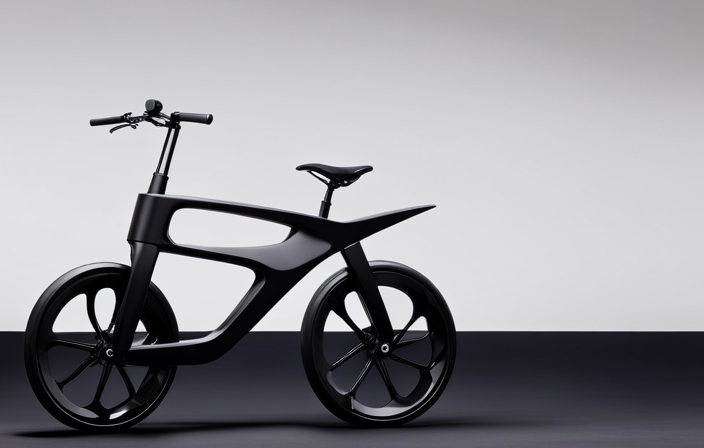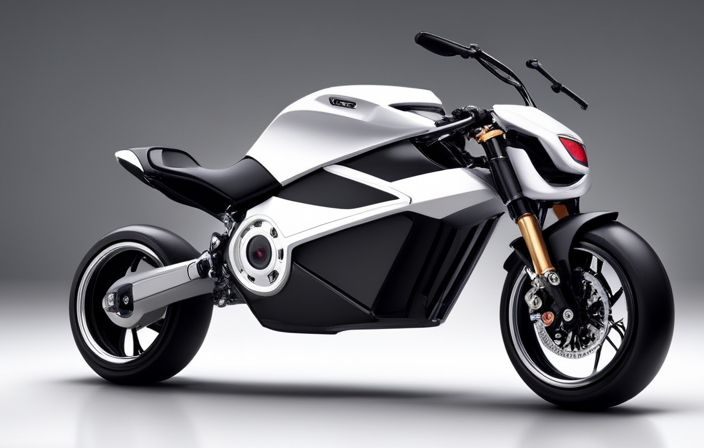Did you know that the cost of a battery for an electric bike can range from $200 to $1,000? That’s a significant investment to consider when purchasing an electric bike.
In this article, I will provide you with a comprehensive guide on the various factors that affect battery costs, the different types of batteries available, and additional expenses to consider.
By the end, you’ll have all the information you need to make an informed decision when it comes to choosing the right battery for your electric bike.
Key Takeaways
- Battery costs for electric bikes can vary depending on factors such as battery type, capacity, and brand reputation.
- Lithium-ion batteries are generally more expensive but offer better performance and longer lifespan compared to lead-acid batteries.
- The average price range for electric bike batteries is $200 to $800, with higher capacity or well-known brand batteries costing over $1000.
- Additional costs to consider include alternative power sources for recharging, the cost of chargers and maintenance, and the impact of these costs on overall ownership expenses.
Types of Electric Bike Batteries
There are various types of electric bike batteries available in the market. Battery technology has come a long way, and now there are several options to choose from.
One of the most common types is the lithium-ion battery, which is known for its high energy density and long lifespan.
Another popular option is the nickel-metal hydride (NiMH) battery, which is known for its lower cost and good overall performance.
Additionally, there are also lead-acid batteries, which are the least expensive option but have a lower energy density and shorter lifespan.
When considering electric bike batteries, it’s important to also consider battery capacity, as it determines how far you can ride on a single charge.
Factors affecting battery costs include battery type, capacity, and brand reputation, among others.
Factors Affecting Battery Costs
To determine the price of an e-bike battery, you should consider various factors that influence its cost.
One of the most important factors is the battery’s performance. Factors such as the capacity, voltage, and chemistry of the battery can greatly impact its performance and, consequently, its price. Higher capacity batteries tend to have a longer range and are therefore more expensive. Similarly, batteries with higher voltage can deliver more power and are priced accordingly.
Another crucial factor is the quality of the battery. High-quality batteries are often more expensive but offer better performance and longer lifespan, resulting in a higher overall electric bike performance. It is important to note that the cost of the battery is not solely determined by its performance, but also by market demand and supply.
Transitioning into the subsequent section, let’s compare the two most common types of e-bike batteries: lithium-ion batteries vs. lead-acid batteries.
Lithium-Ion Batteries vs. Lead-Acid Batteries
When comparing lithium-ion batteries and lead-acid batteries, you should consider their differences in terms of performance and lifespan.
Lithium-ion batteries are widely used in electric bikes due to their high energy density, light weight, and longer lifespan compared to lead-acid batteries. They have a higher energy-to-weight ratio, allowing electric bikes to have a longer range. Additionally, lithium-ion batteries can be charged and discharged more efficiently, resulting in better overall performance.
On the other hand, lead-acid batteries are cheaper and have been used for a long time in various applications. However, they are heavier, have a shorter lifespan, and require more maintenance. Despite these drawbacks, lead-acid batteries are still chosen by some electric bike riders who prioritize cost over performance.
Moving on to the subsequent section about the average cost range for electric bike batteries…
Average Cost Range for Electric Bike Batteries
The average price range for e-bike batteries varies depending on several factors. These factors include the type of battery, capacity, brand, and where it is purchased.
The most common type of battery for electric bikes is the lithium-ion battery, which tends to be more expensive than lead-acid batteries but offers a longer lifespan and better performance. On average, you can expect to pay between $200 and $800 for an electric bike battery. However, higher capacity batteries or those from well-known brands can cost upwards of $1000.
It’s important to note that the lifespan of an electric bike battery can be affected by various factors such as temperature, charging habits, and overall usage. Considering these factors, it’s crucial to choose a battery that suits your specific needs and requirements.
Moving on to additional costs to consider, there are some factors that can impact the overall cost of owning an electric bike.
Additional Costs to Consider
Don’t forget to factor in the additional costs associated with owning an e-bike. While the upfront cost of purchasing an electric bike battery is a significant consideration, there are other expenses to keep in mind.
One of the most important cost-saving tips is to consider alternative power sources for recharging your battery. Solar panels can be a great investment, allowing you to harness the power of the sun to charge your battery and reduce your dependency on the electrical grid.
Additionally, you may need to purchase a charger if one is not included with your battery. It’s also essential to factor in the cost of regular maintenance and replacement parts.
By considering these additional costs, you can make a more informed decision when it comes to purchasing and maintaining your electric bike battery.
Speaking of saving money, let’s explore some ways to save money on electric bike batteries without compromising quality.
Ways to Save Money on Electric Bike Batteries
One way to save money on e-bike batteries is by considering alternative power sources for recharging.
While most electric bike batteries are designed to be charged through a standard electrical outlet, there are other options available that can help reduce your electricity costs.
Solar panels, for example, can be installed to harness the power of the sun and charge your battery for free. Another option is using a portable generator or a power station to recharge your battery while on the go.
Additionally, implementing good battery maintenance practices can extend the lifespan of your battery, saving you money in the long run. This includes regularly checking the battery’s voltage, keeping it clean and dry, and avoiding extreme temperatures.
By being mindful of these factors, you can maximize the lifespan of your battery and ultimately save money.
Moving on to factors to consider when choosing a battery…
Factors to Consider When Choosing a Battery
When it comes to electric bike batteries, there are several factors to consider before making a decision.
The first and most important factor is the type of battery. There are various battery types available in the market, each with its own pros and cons. For example, lithium-ion batteries are lighter and have a longer lifespan, but they can be more expensive. On the other hand, lead-acid batteries are cheaper, but they are heavier and have a shorter lifespan.
Other factors to consider include the battery capacity, which determines how far you can travel on a single charge, and the charging time. It is also important to consider the compatibility of the battery with your electric bike model.
By carefully considering these factors, you can choose a battery that best suits your needs and budget.
Now let’s move on to common battery FAQs.
Common Battery FAQs
When it comes to electric bike batteries, there are several common questions that often arise.
One of the most important factors to consider is how long the battery will last.
Additionally, many people wonder if it is possible to upgrade their electric bike battery to a more powerful or longer-lasting one.
Proper maintenance is also crucial, and knowing how to care for and extend the lifespan of your battery is essential.
Lastly, some individuals may be curious if they can use a battery from a different brand with their electric bike.
How long does an electric bike battery last?
The lifespan of an electric bike battery varies depending on usage and maintenance. Proper charging and maintenance techniques can significantly extend the life of your battery. Here are some tips for maximizing your electric bike battery’s lifespan:
-
Avoid overcharging: Overcharging can cause the battery to degrade faster. Always unplug the charger once the battery is fully charged.
-
Store at the right temperature: Extreme temperatures can damage the battery. Store it in a cool, dry place when not in use.
-
Regularly charge and discharge: Keeping the battery charged between 20% and 80% helps prolong its lifespan.
-
Avoid deep discharges: Fully depleting the battery regularly can reduce its overall capacity.
-
Use the correct charger: Using a charger specifically designed for your electric bike battery ensures optimal charging.
Now, let’s move on to the next section: ‘Can I upgrade my electric bike battery?’
Can I upgrade my electric bike battery?
When it comes to the lifespan of an electric bike battery, it’s important to consider the option of upgrading. Many riders wonder if they can upgrade their electric bike battery to increase its capacity and extend their riding range. The good news is that in most cases, it is possible to upgrade the battery size of an electric bike.
However, before making the decision, it’s essential to weigh the pros and cons. Upgrading the battery capacity can significantly increase the range of your electric bike, allowing you to go further on a single charge. On the other hand, it may come with a higher price tag and added weight. Additionally, upgrading the battery may require modifications to the bike’s electrical system.
Transitioning into the subsequent section about how to properly maintain an electric bike battery, it’s crucial to understand the importance of regular care and charging habits.
How do I properly maintain my electric bike battery?
To properly maintain an electric bike battery, it’s important to follow a regular care and charging routine. Here are four key steps to ensure the longevity and performance of your battery:
-
Proper Storage: When not in use, store your battery in a cool, dry place away from extreme temperatures. Avoid leaving it in direct sunlight or in freezing conditions.
-
Charging Techniques: Follow the manufacturer’s guidelines for charging your battery. Use the original charger or a compatible one recommended by the manufacturer. Avoid overcharging or undercharging the battery, as it can negatively impact its lifespan.
-
Regular Maintenance: Clean the battery terminals and connectors regularly to remove dirt and corrosion. Inspect the battery for any signs of damage or wear, and address any issues promptly.
-
Battery Health Monitoring: Keep track of your battery’s health by monitoring its voltage and capacity regularly. This will help you identify any potential problems and take necessary actions.
By following these maintenance practices, you can ensure optimal performance and extend the lifespan of your electric bike battery.
Speaking of battery options, let’s dive into the next topic: Can I use a different brand of battery for my electric bike?
Can I use a different brand of battery for my electric bike?
Using a different brand of battery for my e-bike might affect its performance and compatibility. Battery compatibility is crucial for the optimal functioning of an electric bike.
While it may be tempting to opt for a cheaper alternative or a different brand, it is advisable to stick with the original brand battery. The original brand battery is specifically designed and tested for your e-bike model, ensuring seamless integration and optimal performance. It guarantees that the battery’s voltage, capacity, and charging mechanisms are perfectly matched to your e-bike’s electrical system. This ensures maximum efficiency, longer battery life, and better overall performance.
Straying from the original brand may result in compatibility issues, reduced performance, and potential damage to your e-bike. Therefore, it is recommended to use the original brand battery to ensure the best compatibility and performance for your e-bike.
Transitioning to the subsequent section about ‘best practices for extending battery life,’ let’s explore some effective strategies.
Best Practices for Extending Battery Life
One of the best practices for extending the battery life of an electric bike is to avoid overcharging it. Overcharging can lead to accelerated battery degradation and reduced overall lifespan. It is important to follow the manufacturer’s recommended charging tips, such as not leaving the battery connected to the charger for an extended period of time once it is fully charged.
Additionally, proper storage is crucial for preserving the battery’s health. When storing the electric bike for an extended period, it is advisable to keep the battery at a moderate temperature, ideally between 20-25 degrees Celsius, and ensure it is around 50% charged. This helps to prevent excessive discharge or overcharging during storage, both of which can negatively impact battery life.
By following these charging and storage recommendations, you can optimize the lifespan of your electric bike battery and enjoy prolonged usage.
Moving on to resources for purchasing electric bike batteries…
Resources for Purchasing Electric Bike Batteries
There are various online retailers and specialty stores where you can find a wide selection of electric bike batteries. When purchasing a battery, it is important to consider the battery warranty, as this will ensure that you can get a replacement or repair if any issues arise.
Some popular online retailers for electric bike batteries include Amazon, eBay, and Electric Bike Paradise. These platforms offer a range of options, from high-end brands to more affordable options.
Additionally, specialty stores such as REI and BikeBerry also carry electric bike batteries and provide expert advice on choosing the right battery for your specific needs.
It is also important to note that when disposing of old electric bike batteries, it is crucial to recycle them properly. Many local recycling centers or battery retailers have collection points where you can drop off your old batteries for safe and environmentally friendly disposal.
Frequently Asked Questions
Are there any safety precautions I should take when charging or using an electric bike battery?
When it comes to charging safety and battery maintenance for electric bikes, there are several precautions to keep in mind. It’s important to follow manufacturer guidelines, avoid overcharging, use the correct charger, and store the battery in a cool, dry place.
Can I use a different brand or type of battery for my electric bike?
Yes, it is possible to use a different brand or type of battery for your electric bike. However, it is important to ensure battery compatibility and consider factors such as voltage, capacity, and size to ensure optimal performance and safety.
How long does it typically take to charge an electric bike battery?
On average, it takes around 3-4 hours to fully charge an electric bike battery. However, charging times can vary depending on the battery capacity and charger used. It’s important to note that frequent charging can impact the overall lifespan of the battery.
Is it possible to upgrade the battery on my electric bike?
Yes, it is possible to upgrade the battery on my electric bike. However, it is crucial to consider battery compatibility to ensure optimal performance. Compatibility with the bike’s electrical system and voltage requirements must be taken into account.
Are there any warranties or guarantees available for electric bike batteries?
Yes, there are warranties and guarantees available for electric bike batteries. These can vary depending on the manufacturer, but they typically cover defects or malfunctions within a specific period. Proper battery maintenance can also help extend the battery lifespan.
Conclusion
After exploring the different types of electric bike batteries and the factors that affect their costs, it is clear that purchasing a battery for an electric bike is not a decision to be taken lightly.
With additional costs to consider and various factors to keep in mind, it is crucial to make an informed choice.
By understanding the common battery FAQs and following best practices for extending battery life, you can ensure that your electric bike battery lasts as long as possible.
Don’t miss out on these valuable resources for purchasing electric bike batteries.
















